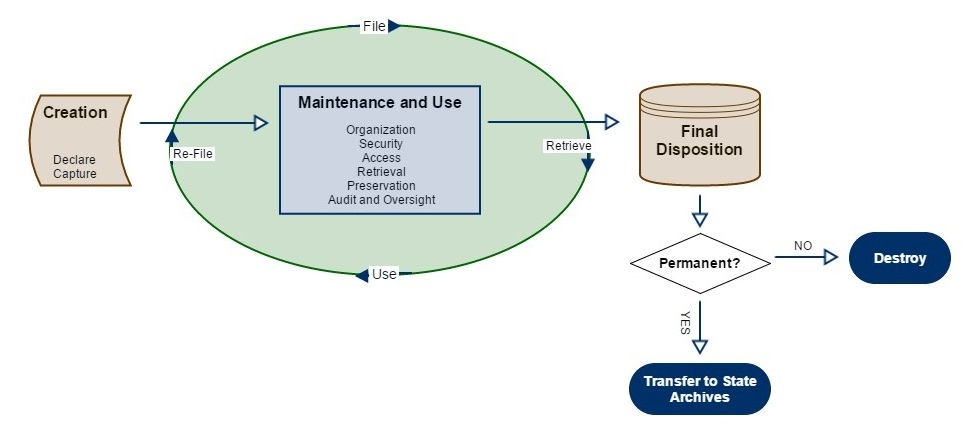
|
Records Management Essentials |
Home  Records Management Essentials
Records Management Essentials  Section 2
Section 2  2.4. Scheduling the lifecycle of your records
2.4. Scheduling the lifecycle of your records
2.4. Scheduling the lifecycle of your records
Records should be managed at each stage of their lifecycle, from the time that they are created to the time that they cease to hold any administrative, legal, or fiscal value, and are destroyed or are preserved for their historical value.
The lifecycle of a record is: creation, maintenance and use, and disposition. In the first phase, a record is created, received, or captured. In the second phase, records are maintained and used actively or inactively until retention is met. Records being actively used should be housed in a way that allows for easy access and minimizes loss or physical damage to the materials. Active records are often used by many people and need to be tracked for retrieval purposes. Inactive records are used less than once a month but must be retained for occasional reference or to meet audit or legal obligations; once inactive, records may feasibly be moved outside of the immediate office area or to off-site storage.
The last phase, disposition, arrives when records have met their retention, at which point they must either be destroyed according to schedule or, if they have historical value, be maintained permanently. The records management lifecycle is depicted below.

Created by Kendra Yates
In order to manage records through the different phases of their lifecycle, we identify and organize them into groups based on similarities of function, subject, access, retention need, or other logical criteria. These groups are defined in GRAMA as record series. We associate record series with record retention schedules in order to plan the implementation of each phase in the records’ lifecycle. The retention period expressed in the retention schedule specifies the time period that records should be maintained in agency custody prior to disposition. This time period is based on the estimated frequency of use, the appraised value of the records, and any statutes or rules specifying how long the records should be kept.1 Section one of this training describes different types of retention schedules, and section three details how to use retention schedules.
The last phase in the records management lifecycle is disposition, which occurs when the retention period has been met, and the administrative use has ended. Disposition means the act of disposing of records or transferring custody of them to an appropriate repository. Records have a disposition of destroy or of never destroy, which is usually phrased as “transfer to the State Archives,” where they can be preserved permanently.
Records of enduring historical value that warrant continued preservation beyond the period required to transact the business of the originating agency, or its successor, should be transferred to State Archives’ custody when retention has been met. This includes records that
- document significant activities of an organization or agency
- are useful for research due to their information on persons, places, subjects, or events of interest; and
- are of inherent worth based upon factors of age, content, circumstances of creation, or other unique features.
After the retention has been met, the State Archives takes custody of records with the disposition of “Transfer to the State Archives,” and assumes responsibility for their management and preservation. Access to these records is then handled by the State Archives. Members of the public or of government agencies can access over five million records online at archives.utah.gov. Records not presented online can be accessed via the History Research Center, located at the Rio Grande building in Salt Lake City.
1Utah State Archives, Utah state government records management handbook 2008 (Salt Lake City, UT: Utah State Archives & Records Service, 2008), 8.